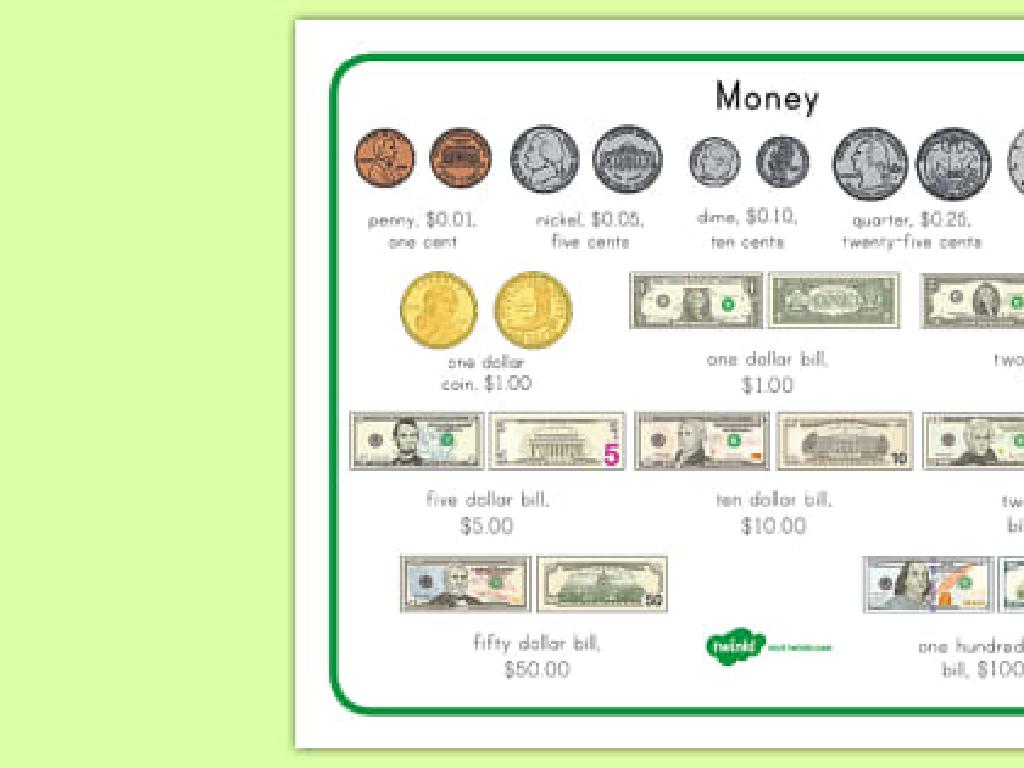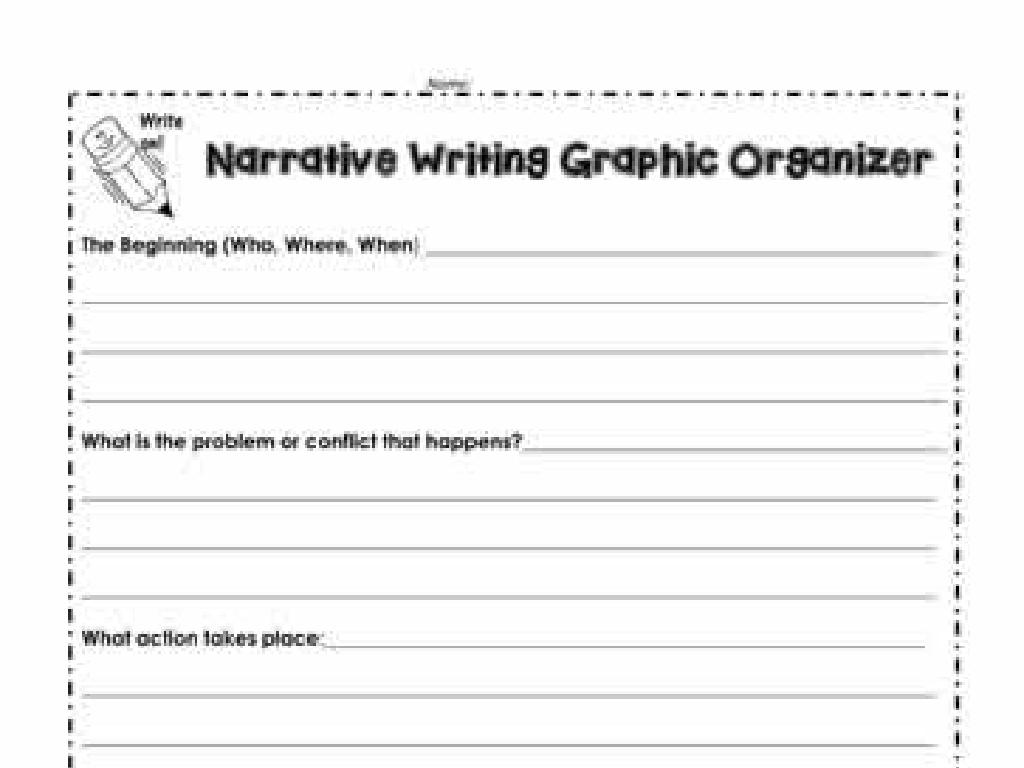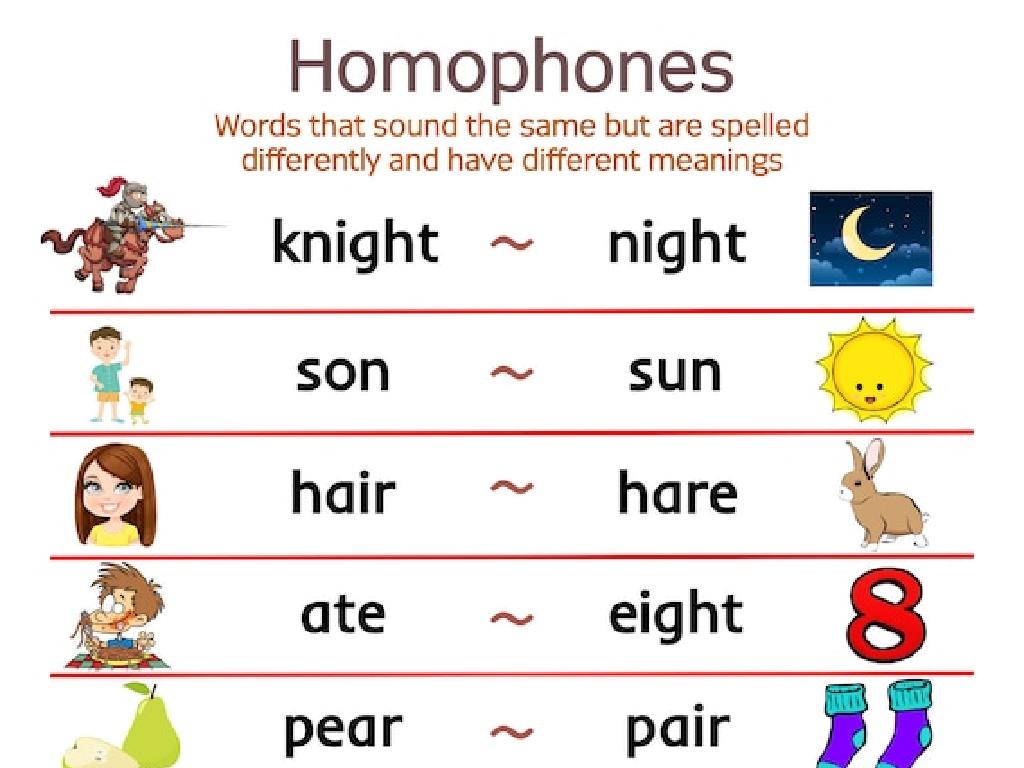Compare And Order Fractions
Subject: Math
Grade: Seventh grade
Topic: Fractions
Please LOG IN to download the presentation. Access is available to registered users only.
View More Content
Comparing and Ordering Fractions
– Understanding fraction values
– Grasp that fractions represent parts of a whole
– Daily life fraction examples
– Cooking recipes, time, and money involve fractions
– Comparing fractions methods
– Use cross-multiplication or convert to like denominators
– Ordering fractions practice
– Arrange fractions from smallest to largest or vice versa
|
This slide introduces the concept of comparing and ordering fractions, which is a fundamental skill in mathematics and is widely applicable in everyday life. Start by explaining that fractions represent parts of a whole and can have different values even if the numerators or denominators are the same. Provide relatable examples such as using fractions in cooking (e.g., 1/2 cup of sugar), time (e.g., quarter past three), and money (e.g., 3/4 of a dollar). Teach students how to compare fractions by finding common denominators or using cross-multiplication. Then, guide them through the process of ordering fractions by size, which can be done by converting them to equivalent fractions with a common denominator or by comparing their decimal forms. Encourage students to practice these skills with real-life examples and exercises.
Understanding Fractions
– Definition of a fraction
– A fraction represents a part of a whole
– Numerator and Denominator roles
– Numerator: top number, Denominator: bottom number
– Fractions in daily life
– Half a pizza, quarter of an hour
– Comparing fractions
– Use common denominators or cross-multiplication
|
Begin with the basic definition of a fraction to ensure students understand that it represents a part of a whole. Clarify the roles of the numerator and denominator, with the numerator indicating how many parts are being considered and the denominator showing the total number of equal parts the whole is divided into. Provide relatable examples such as portions of pizza or segments of time to illustrate fractions in a context familiar to students. Then, introduce the concept of comparing fractions by finding common denominators or using cross-multiplication, setting the stage for more complex operations with fractions.
Understanding Equivalent Fractions
– Define equivalent fractions
– Fractions that have the same value, even if they look different
– Finding equivalent fractions
– Multiply or divide the numerator and denominator by the same number
– Practice with examples
– Identify fractions that represent the same part of a whole
– Ordering by equivalence
– Arrange fractions to show they are the same by finding common numerators or denominators
|
This slide introduces the concept of equivalent fractions, which are different fractions that represent the same part of a whole. To find equivalent fractions, students can multiply or divide the numerator and denominator of a fraction by the same non-zero number. Provide practice examples for students to identify sets of equivalent fractions. Emphasize the importance of understanding equivalence when comparing and ordering fractions, as it is a foundational skill for working with fractions in various mathematical contexts. Encourage students to practice by creating their own sets of equivalent fractions and explaining their reasoning.
Comparing Fractions: Which is Larger?
– Understanding fraction comparison
– Learn to determine the size of fractions relative to each other
– ‘Cross-multiplication’ technique
– Multiply across the fractions to compare without common denominators
– Step-by-step practice problems
– Work through examples to solidify understanding
– Applying comparison skills
|
This slide introduces the concept of comparing fractions, a fundamental skill in understanding and working with fractions. Start by explaining that fractions represent parts of a whole and that comparing them helps us understand their relative sizes. Introduce ‘cross-multiplication’ as a method to compare fractions without finding a common denominator, which involves multiplying the numerator of one fraction by the denominator of the other and comparing the products. Provide practice problems and guide students through the solutions step-by-step to ensure they grasp the concept. Encourage students to apply these skills in various contexts and remind them that understanding how to compare fractions is crucial for more advanced math concepts.
Ordering Fractions: Least to Greatest
– Steps to order fractions
– List fractions, find least to greatest by comparing
– Convert to common denominators
– Make denominators the same to compare easily
– Class activity: Arrange fractions
3/8, 1/4, 5/8, 1/2 – use common denominators to order
– Understanding ordering importance
|
Begin by explaining the steps to order fractions, emphasizing the importance of comparing fractions with a common denominator. Demonstrate how to convert fractions so they all have the same denominator, making it easier to see which are larger or smaller. For the class activity, provide the fractions 3/8, 1/4, 5/8, 1/2 and guide students to find a common denominator and arrange them in order. Discuss why understanding how to order fractions is crucial in math and real-life situations. The activity will help solidify the concept and give students hands-on experience. Possible variations for the activity could include using visual aids, fraction strips, or interactive online tools to help students visualize the fractions’ sizes.
Using Benchmarks to Compare Fractions
– Understanding benchmark fractions
– Benchmarks are common fractions used for reference, like 0, 1/2, and 1.
– Using 0, 1/2, and 1 as references
– 0 is the smallest, 1/2 is the middle, and 1 is the largest in value.
– Comparing fractions to benchmarks
– Determine if fractions are less than, equal to, or more than 1/2.
– Ordering fractions with benchmarks
– Arrange fractions by comparing each to 0, 1/2, and 1.
|
This slide introduces the concept of benchmark fractions, which are fractions commonly used as points of reference to help compare and order other fractions. Students should understand that 0, 1/2, and 1 are key benchmarks that represent the smallest, middle, and largest values typically used. Teach students how to compare other fractions to these benchmarks to decide if they are smaller or larger than 1/2, and then use this information to order the fractions. For example, a fraction less than 1/2 is closer to 0, and a fraction more than 1/2 is closer to 1. This method simplifies the process of comparing and ordering fractions without finding common denominators. Encourage students to practice with different sets of fractions and to explain their reasoning when using benchmarks.
Real-life Applications of Fractions
– Fractions in cooking
– Recipes often require half, quarter measurements
– Fractions in time management
– Scheduling activities, dividing hours into fractions
– Discuss real-life fraction usage
– Share personal experiences with fractions
– Understanding fractions’ importance
|
This slide aims to show students the practical applications of fractions in everyday life. Cooking and recipes frequently use fractions to measure ingredients, such as 1/2 a cup of sugar or 1/4 teaspoon of salt. Time management is another area where fractions are used, for example, planning to spend 3/4 of an hour on homework. Encourage students to participate in a group discussion to share where they have encountered fractions in their own lives, reinforcing the concept that fractions are not just theoretical but are used in various real-world contexts. This will help students see the relevance of what they learn in class to the world outside, thereby enhancing their understanding and retention of the concept of fractions.
Class Activity: Fraction Scavenger Hunt
– Find classroom items as fractions
– Compare and order your fractions
– Use >, <, = to order the fractions you find
– Present your fraction findings
– Explain how you determined the order
– Reflect on the activity
|
This interactive activity is designed to help students apply their knowledge of comparing and ordering fractions in a fun and engaging way. Students will search the classroom for items that can represent fractions, such as a half-eaten apple or a clock showing a quarter past the hour. They will then use their understanding of fractions to compare and order these items, using greater than, less than, or equal to signs. Encourage students to think critically about the size of fractions and how to determine their order. After the scavenger hunt, students will present their findings to the class, explaining their reasoning. This will help reinforce their understanding and allow for peer learning. As a reflection, ask students to discuss what they learned and how this activity helped them understand fractions better.
Conclusion & Homework: Mastering Fractions
– Recap: Comparing & Ordering Fractions
– Review key methods to compare fractions like cross-multiplication and common denominators.
– Mastery Importance
– Understanding fractions is crucial for advanced math concepts and real-life applications.
– Homework Assignment
– Complete the provided worksheet to practice your skills.
– Next Class Preparation
– Be ready to discuss your answers and any challenges you faced.
|
As we conclude today’s lesson, remind students of the different strategies we’ve learned for comparing and ordering fractions, such as finding a common denominator or using cross-multiplication. Emphasize the importance of mastering these skills, as they are foundational for understanding more complex mathematical concepts and have practical applications in everyday life. Assign the worksheet as homework to reinforce today’s lesson, and encourage students to try their best, assuring them that we will review the answers together in the next class. This will help them to solidify their understanding and prepare them for upcoming topics.






